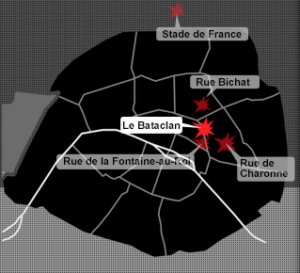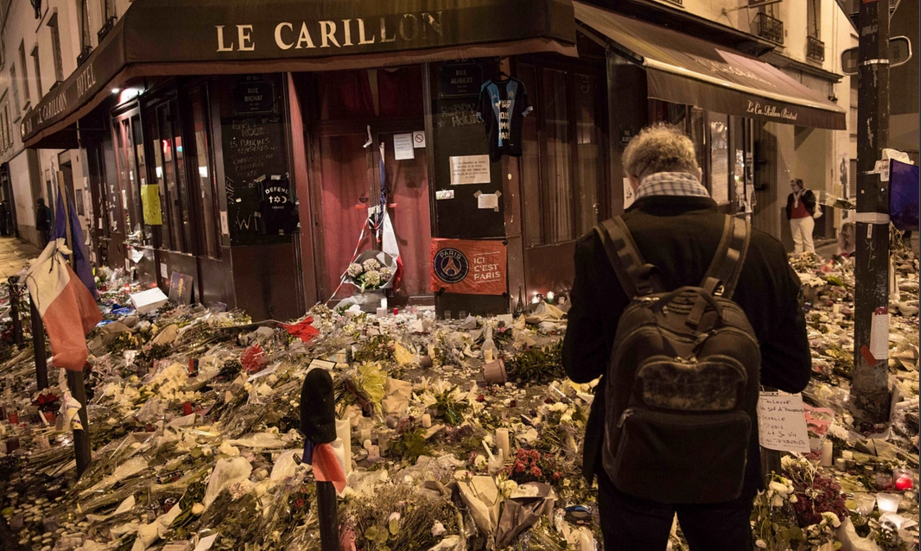Paris, November 13th 2015: bars, concert venues, and the football stadium targeted by gunmen. A bloodbath which reaches international headlines immediately and draws support reactions from throughout the world. 129 victims and hundreds of wounded, all the attackers shot or killed themselves.
A few weeks after witnessing these events from abroad, without being able to participate in the memorials and congregations of the following days, and without having a direct connexion with the victims of the Paris attacks, my question is: how are these events going to be remembered? Which meanings and representations are they being given? In the end, how is collective memory being built –i.e., being written into history?
Based on a reading of Pierre Nora, I’m interested in following this transition from memory (untold, living, ‘organic’) to its written trace, to its recording. Arguably, the archival production of our society has grown exponentially, to the point that every single event can now be considered worthy of documentation for historical purposes, a frenzy which both is explained and contributes to the disappearance of true memories.
“Lieux de mémoire originate with the sense that there is no spontaneous memory that we must deliberately create archives, maintain anniversaries, organize celebrations, pronounce eulogies, and notarize bills because such activities no longer occur naturally (…) –that without commemorative vigilance, history would soon sweep them away.”
Pierre Nora. “Between Memory and History: Les Lieux de Mémoire” (1989)
What will be the Lieu de Mémoire for the Paris attacks? It is impossible for me to collect information about the evolution of the material spaces where the attacks occurred. Hence, let’s take a look at the digital (narrated) space. This post is meant to analyze the superficial layers of information which are relayed through official sources –with time, more in-depth analyses will be possible, looking at more diverse data, but it is not the purpose of this article. Neither will this get into analytical detail on contemporary terrorist networks and their related theories, although there is much to be said about relativity and double standards in media coverage of terrorism when taking a look at this simple video. Here, I want to focus on the different narratives that have been woven at the national level (why the national level? more on this later) to start making sense of these traumas, inevitably pulling together correlations between local, regional and global actors.

The map on Le Monde’s digital memorial [source]
The digital memorial also categorizes each entry according to the place of their death, increasing the precision of the written record, enabling rapid statistical interpretation, and linking the stories with the physical location in an abstract way –via a simplified map of Paris which shows the river, administrative boundaries and, with bright red explosion symbols, the sites of the attacks. I wonder if there is today, on the site of the shootings and bombings, a physical marker of the events. Has this digital recording of the casualties already become a Lieu de Mémoire for the events already? Have we lost our capacity of memory into one of history?
Referring again to Pierre Nora, if we consider that history is the “reconstruction, always problematic and incomplete, of what is no longer” (p. 8), it becomes clear that this event was immediately turned into a historical, digital trace. Indeed, stories now reconstruct the stream of events in the city, set up chronologies of terrorist events in 2015, trace the Islamic networks in France and Belgium, explain the attacks through international relations, advance conspiracy theories, etc. In our modern way of communicating, visual representations are necessary to sustain and recall the past; the present is recorded and transmitted by and for anyone with the appropriate technological tools. It becomes history, then, a social production built by an infinity of actors and which indicates that the Paris attacks were, in fact, completely virtual for most people.
The locations of the attacks, now, bear few physical traces of the attacks. The cafés have reopened, the Bataclan is undergoing a renovation, there are just a few flowers on the street –all the memorial apparatus has been moved to the symbolic Place de la République, which can also host large congregations, unlike narrow winding streets and café terraces. As an act of defiance, the crowd which usually comes to party in this area on the weekends has come back, and it does not seem like the Paris attacks have fundamentally altered the story of these neighborhoods. As a matter of fact, some even incorporate it in a long-standing narrative of urban violence, as voiced by Hatem, a local resident: “Ce quartier du Faubourg Saint-Antoine qui a fait la Révolution française ne baissera jamais les bras”: “This neighborhood of the Faubourg Saint-Antoine, which has made the French Revolution, will never give in” (November 14th, 2015 – N. Falez for RFI).
In the representational space, however, the map of Paris after the attacks is different: a few bright red explosion signs, which mark the location of the attacks. It is an immediate reminder of the larger political realms involved in the situation. It is not a miniature model of reality but rather a heavily charged symbol depicting an interpretation of what has happened, and what is to come –it is a plan. Following Judith Tyner, it is a persuasive tool, created to send a message which alters significantly the sense of grief and loss conveyed by the personal stories of the victims.
What does the symbol of an explosion stand for? Not death. It stands for an explosion, a bombing, an armed intrusion –and depicts, in fact, the way the French president read these attacks the very next day:
«C’est un acte de guerre commis contre les valeurs que nous défendons et ce que nous sommes: un pays libre. C’est un acte de guerre préparé. Planifié de l’extérieur avec une complicité intérieure que l’enquête établira»
“This is an act of war committed against the values which we defend and embody: a free country. It is a planned act of war. Planned from the outside, and with an insider complicity that the investigation will unveil”
François Hollande, November 14th 2015 (source)
There are two ways to read this statement –one narrative, and one plan, expertly interwoven together in a causal relation. The first holds that France is, at the international level, a symbol for some universal values –freedom, democracy, equality– which are defendable by all. These attacks are therefore attacks against the world; Gavin Murray-Miller examines how this meaning has been constructed around the Republic of France for the past two centuries (at least), where political discourse has eventually “linked a beleaguered republic with the cause of humanity”. The second reading of Hollande’s statement is a declaration of war, complete with a justification (France is innocent, “a free country”), a target (“the outside”), and a plan (“the investigation”).
“In the wake of yet another horrific incident, the world is reminded of the strong republican self-image that has been central to the course of modern French politics. ‘La république est en danger’ is representative of a still greater danger, one ‘threatening the whole world’, as Hollande had intimated.”
Gavin Murrey-Miller, “The Paris Attacks and France’s Republican Tradition”, November 17th 2015 (source)
And Murray-Miller is correct in asserting that these representations are performed within civil society itself. Meaning arises at the very moment the question “why” starts being answered; and while the map of the digital memorial recalled the martial symbol of an explosion, the editorial emphasizes the innocence and universality of the places targeted by the Paris attacks:
“D’abord, pourquoi les terroristes avaient choisi de frapper là, à ces endroits précis de Paris. Le Bataclan, bien sûr, temple mythique de la musique et du rock. Mais surtout ces restaurants et ces cafés des 10e et 11e arrondissements, des lieux d’habitués. Des cafés un peu en retrait des grandes avenues, où l’on connaissait le patron et les serveurs, où l’on avait une chance de retrouver des visages familiers. Des endroits où l’on se mélangeait, juifs, chrétiens ou musulmans, hommes ou femmes. Des endroits où l’on savait vivre ensemble.”
“First of all, why the terrorists had chosen to hit here, in these specific places of Paris. The Bataclan, of course, mythical temple of music and rock n’roll. But especially these restaurants and cafés of the 10th and 11th district, places where the regulars go. Cafés a little remote from big avenues, where you knew the owner and the waiters, where it was possible to run into familiar faces. Places where people mixed, jews, christians and muslims, men and women. Places where we knew how to live together.”
Aline Leclerc & Sylvie Kauffmann, “Un Mémorial pour les morts du 13 Novembre”, November 26th 2015 (source)
Hence the future representation of the sites of the attacks remains uncertain. Are they to become cradles of universal freedom and democracy, symbols of the innocent Republic, tokens for the great social mix of inner Paris and all of France? Or will they be, perhaps, the catalyst to the Third World War, which may have already begun?
J.V. Micallef argues that, more than current geopolitical and economic tensions borne out of the Cold War, the Paris attacks can be placed in a linear logic with the ancient, insolvable opposition between the Judeo-Christian and the Muslim worlds, classifications which are of course fragmented in themselves and sometimes oppositional (on this topic, see also the works of sociologist Emmanuel Todd, for his controversial analysis of the predominantly Judeo-Christian participation in protests after the Charlie attacks in January).
History classes for middle schools, in a decade or a hundred years, could take a tour in these bars and venues when covering the topic of the crusades and religion wars. Perhaps they will erect a memorial for the martyrs of the republic, whose death is a symbol for the unfair assault of the republic by the evils of religious extremism. I will keep an eye out for future maps to inspect the meaning given to these new Parisian Lieux de Mémoires…
References
Lefebvre, Henri. (1974) La production de l’espace, Anthropos
Nora, Pierre (1989). “Between Memory and History: Les Lieux de Mémoire.” In Representations, No. 26, Special Issue: Memory and Counter-Memory (Spring, 1989), pp. 7-24
Todd, Emmanuel (2015). Who is Charlie? Sociology of a Religious Crisis, Seuil.
Tyner, Judith A. (2015). “Persuasive Cartography.” In Cartography in the Twentieth Century, ed. Mark Monmonier, 1087-95.
[/av_textblock]

